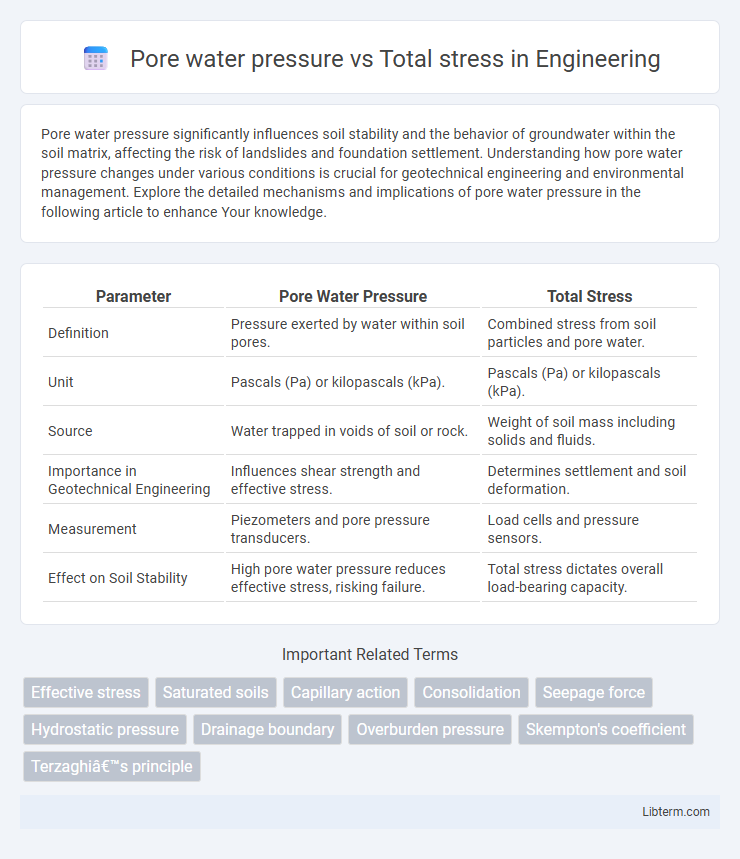Pore water pressure significantly influences soil stability and the behavior of groundwater within the soil matrix, affecting the risk of landslides and foundation settlement. Understanding how pore water pressure changes under various conditions is crucial for geotechnical engineering and environmental management. Explore the detailed mechanisms and implications of pore water pressure in the following article to enhance Your knowledge.
Table of Comparison
| Parameter | Pore Water Pressure | Total Stress |
|---|---|---|
| Definition | Pressure exerted by water within soil pores. | Combined stress from soil particles and pore water. |
| Unit | Pascals (Pa) or kilopascals (kPa). | Pascals (Pa) or kilopascals (kPa). |
| Source | Water trapped in voids of soil or rock. | Weight of soil mass including solids and fluids. |
| Importance in Geotechnical Engineering | Influences shear strength and effective stress. | Determines settlement and soil deformation. |
| Measurement | Piezometers and pore pressure transducers. | Load cells and pressure sensors. |
| Effect on Soil Stability | High pore water pressure reduces effective stress, risking failure. | Total stress dictates overall load-bearing capacity. |
Introduction to Pore Water Pressure and Total Stress
Pore water pressure refers to the pressure exerted by water within the pores of a soil or rock, significantly influencing soil strength and stability. Total stress represents the combined stress applied to a soil mass, including the weight of overlying soil and any external loads. Understanding the relationship between pore water pressure and total stress is crucial for evaluating effective stress, which governs soil behavior and deformation.
Understanding Soil Mechanics Fundamentals
Pore water pressure represents the pressure exerted by water within soil pores, directly influencing effective stress, which governs soil strength and deformation behavior. Total stress is the combined load per unit area from both soil particles and pore water, serving as the basis for calculating effective stress by subtracting pore water pressure. Mastery of these concepts is essential for predicting settlement, shear strength, and stability in geotechnical engineering and soil mechanics.
Definition of Total Stress in Soils
Total stress in soils refers to the overall force exerted per unit area within a soil mass due to the weight of the soil and any applied loads above it. It encompasses both the effective stress, which governs soil strength and deformation, and the pore water pressure, the pressure exerted by water within the soil pores. Understanding total stress is crucial for analyzing soil stability, settlement, and shear strength in geotechnical engineering applications.
What is Pore Water Pressure?
Pore water pressure is the pressure exerted by water within the pores of a soil or rock mass, significantly influencing the effective stress and stability of geotechnical structures. It arises from the presence of water trapped between soil particles, affecting soil strength and deformation characteristics. Measuring and controlling pore water pressure is essential in fields like foundation engineering, slope stability, and groundwater flow analysis.
Relationship Between Pore Water Pressure and Total Stress
Pore water pressure directly influences the effective stress within a soil mass by reducing the total stress carried by soil particles, which controls soil strength and stability. The relationship between pore water pressure (u) and total stress (s) is expressed through the effective stress principle: effective stress (s') equals total stress (s) minus pore water pressure (u), or s' = s - u. In saturated soils, increases in pore water pressure can lead to decreased effective stress, potentially causing soil liquefaction or failure under load.
Factors Influencing Pore Water Pressure
Pore water pressure is influenced by factors such as soil permeability, rate of loading, and drainage conditions, which determine how fluid pressure builds up within soil pores. Total stress encompasses both the effective stress carried by soil particles and the pore water pressure, directly affecting soil strength and deformation behavior. Understanding the interplay of these factors is crucial for predicting soil stability in geotechnical engineering projects.
Effective Stress Principle in Soil Engineering
Pore water pressure significantly influences the total stress within soil by occupying the void spaces between soil particles, reducing the soil's ability to transmit stress through its solid framework. The Effective Stress Principle states that the soil's strength and deformation behavior depend on the effective stress, which is the total stress minus the pore water pressure. Understanding this relationship is crucial for safe foundation design, slope stability analysis, and predicting soil settlement under load.
Measurement Techniques for Pore Water Pressure and Total Stress
Pore water pressure is commonly measured using piezometers, including vibrating wire and pneumatic types, which provide accurate real-time data on the pressure within soil pores. Total stress measurement relies primarily on earth pressure cells or load cells embedded in soil to capture the overall stress exerted by soil and overlying materials. Combining these techniques enables detailed assessment of effective stress, crucial for geotechnical analysis and foundation design.
Engineering Applications and Implications
Pore water pressure significantly influences soil stability and bearing capacity by altering the effective stress within soil masses, critical for foundation design and slope stability analysis. Total stress represents the overall force per unit area exerted on the soil, but it is the effective stress, defined as total stress minus pore water pressure, that governs soil strength and deformation behavior. Accurate measurement and control of pore water pressure are essential in geotechnical engineering applications such as earth dam construction, tunneling, and liquefaction assessment to prevent structural failures and ensure safety.
Conclusion: Balancing Pore Water Pressure and Total Stress
Balancing pore water pressure and total stress is critical for maintaining soil stability and preventing failure such as landslides or foundation collapse. Effective management involves monitoring changes in pore water pressure to ensure it does not approach or exceed the soil's total stress capacity, which can lead to decreased shear strength. Engineers use this balance in geotechnical design to optimize safety margins while accommodating varying load and groundwater conditions.
Pore water pressure Infographic

 libterm.com
libterm.com